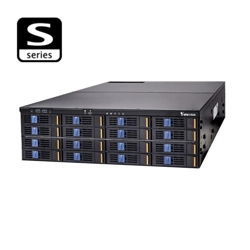Loading ...
Loading ...
Loading ...

VIVOTEK - A Leading Provider of Multimedia Communication Solutions
52 - User's Manual
Segment 1
Segment 7
Segment 13
Segment 2
Segment 8
Segment 14
Segment 3
Segment 9
Segment 15
Segment 4
Segment 10
Parity (11 to 15)
Segment 5
Parity (6 to 10)
Segment 11
Parity (1 to 5)
Segment 6
Segment 12
Segment 19
Segment 25
Parity (26 to 30)
Segment 20
Parity (21 to 25)
Segment 26
Parity (16 to 20)
Segment 21
Segment 27
Segment 16
Segment 22
Segment 28
Segment 17
Segment 23
Segment 29
Segment 18
Segment 24
Segment 30
RAID 6 Drive Groups
A RAID6 drive group is similar to a RAID5 drive group (disk striping and parity), except that
instead of one parity block per stripe, there are two. With two independent parity blocks, A
RAID6 drive group can survive the loss of any two drives in a virtual drive without losing data.
A RAID6 drive group provides a high level of data protection through the use of a second
parity block in each stripe. Use a RAID6 drive group for data that requires a very high level of
protection from loss.
In the case of a failure of one drive or two drives in a virtual drive, the RAID controller uses the
parity blocks to re-create all of the missing information. If two drives in a RAID6 virtual drive fail,
two drive rebuilds are required, one for each drive. These rebuilds do not occur at the same
time. The controller rebuilds one failed drive, and then the other failed drive.The following table
provides an overview of a RAID6 drive group.
Uses Use for any application that has high read request rates but low random or small block
write rates.
Strong points Provides data redundancy, high read rates, and good performance in most environments.
Can survive the loss of two drives or the loss of a drive while another drive is being
rebuilt.Provides the highest level of protection against drive failures of all of the RAID
levels.Performance is similar to that of a RAID5 drive group.
Weak points Not well-suited to tasks requiring a lot of small and/or random write operations.A RAID 6
virtual drive must generate two sets of parity data for each write operation, which results
in a signicant decrease in performance during write operations.
Drive performance is reduced during a drive Rebuild operation.Environments with
few processes do not perform as well because the RAID overhead is not oset by the
performance gains in handling simultaneous processes.
A RAID6 drive group costs more because of the extra capacity required by using two
parity blocks per stripe.
Drives 3 through 32
The following gure shows a RAID6 drive group data layout. The second set of parity drives is
denoted by Q. The P drives follow the RAID5 drive group parity scheme.
Loading ...
Loading ...
Loading ...
